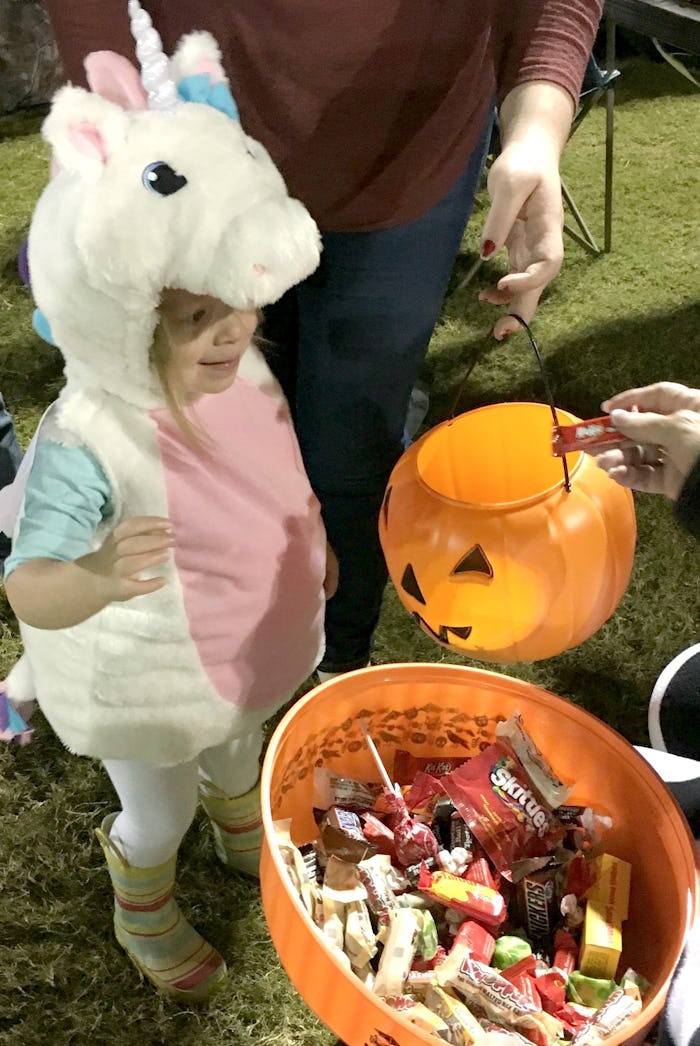News

What Is The History Of Trick-Or-Treating? It's Adapted A Lot To Candy & Pumpkins
Halloween is one of my favorite holidays of the year, but I think everyone can agree that trick-or-treating sounds super weird. I mean, you're dressing your kid up in a costume so they can knock on strangers' doors and ask for either a trick or a treat? If you were someone who had never heard of it, you might be totally confused. So what is the history of trick-or-treating? How did this time-honored tradition begin and what exactly is a "trick" someone could give you instead of a miniature Kit-Kat?
If you ever heard that dressing up was a way to ward off demons on Halloween, you're on the right track. According to Smithsonian.com, dressing up as an evil spirit was a Celtic tradition that happened at the end of the year. Apparently, they believed that as one year ended and another began, the living and the dead would somehow cross paths and demons would be part of earth again. By dressing up as an evil spirit, the idea was that a demon would leave you be, as they would also think you were one of them, simply there to roam as the living and dead came together.
So where do the treats come in? History.com noted that during some Celtic celebrations of the festival known as Samhain, tables were prepared and filled with food and other edible offerings to keep the unwelcome spirits happy. Centuries later, people began to dress as ghosts and other evil beings, performed some kind of antic, and received something to eat and/or drink for it. Apparently this was called mumming and goes back as far as the Middle Ages.
But, like most Pagan rituals, trick or treating has been adapted from its original concept to what it is today. As Christianity spread, History.com noted that Nov. 2 became All Souls' Day and was a day for honoring the dead. Many poor people would spend this day going from house to house of wealthier people to receive pastries known as soul cakes. In exchange, the poor would promise to pray for the souls of the wealthy person's dead family members.
According to Today I Found Out, this exchange was known as "souling" and eventually became "guising" in the United Kingdom during the 19th century. Children would dress up and go door to door telling jokes, singing, or performing and the homeowner would give them fruit or money. A lot like "souling," but without the religious aspect — instead of promising to pray, the kids would just do a jig.
These all sound a lot like our Halloween, but according to The Atlantic, it wasn't until the 1930s that trick or treating as most of the world knows it today was really invented. Children still dressed up and knocked on doors, but they stopped performing to receive the candy. Apparently, the tradition did pretty well until World War II hit. Thanks to sugar rationing, the trick or treat tradition took a break and came back in the 1950s. Despite the obvious idea of candy as a treat, The Atlantic noted that children were often given coins, nuts, fruit, toys, cookies, and cakes instead of candy.
And now? Well now Halloween is a huge deal. According to the National Retail Federation, Americans are estimated to spend a whopping 8.4 billion dollars this year on Halloween, the highest ever recorded in the survey's history. More than 171 million Americans will participate in Halloween and the theory is that after a long summer, families are really looking forward to fall and the first big holiday. And with 2.5 billion dollars being spent on candy alone? Dentists can probably look forward to some extra visits soon.
Halloween may look a lot different after centuries of adaptation, but the concept remains the same — dress up, enjoy some treats, and ward off the evil spirits. I think everyone can get behind it, especially now that the celebration includes Reese's Peanut Butter Cups and a Tim Burton movie. The Celtics had no idea what they were missing.